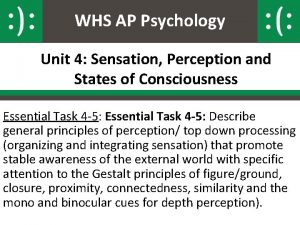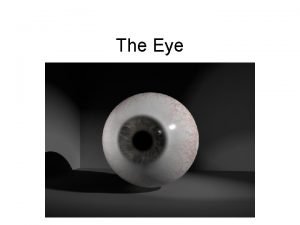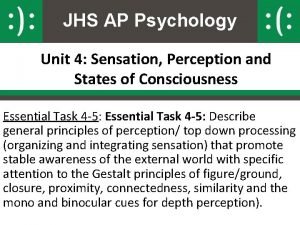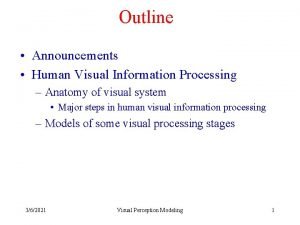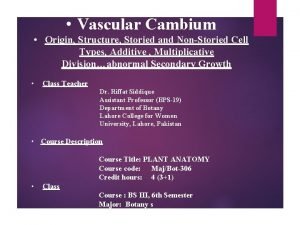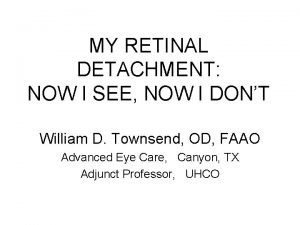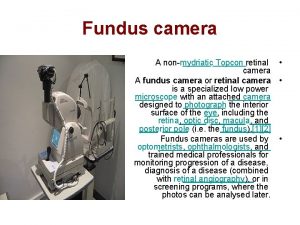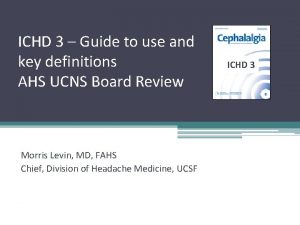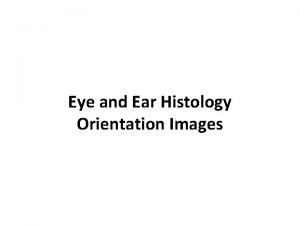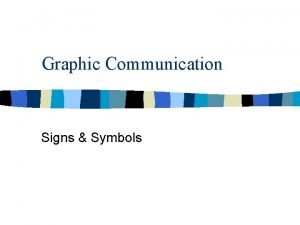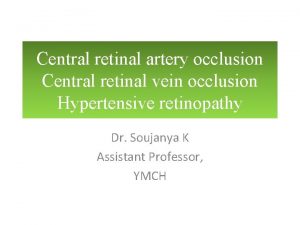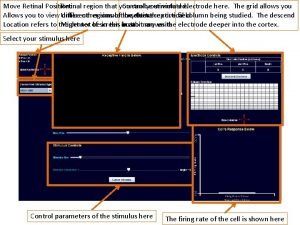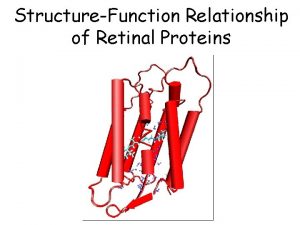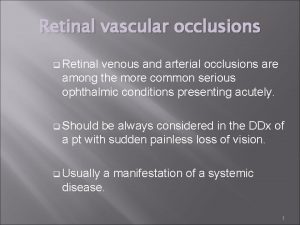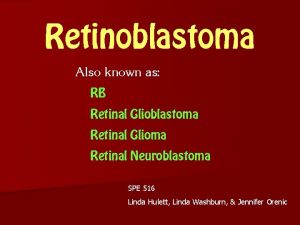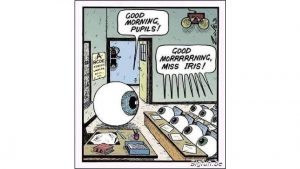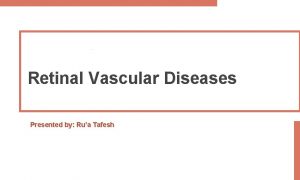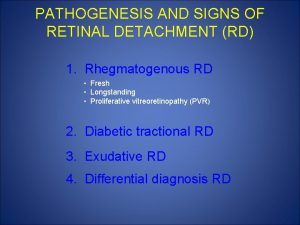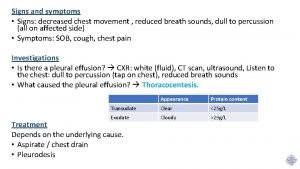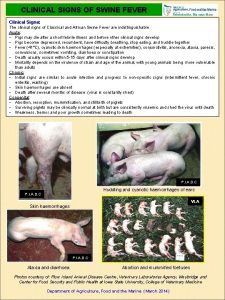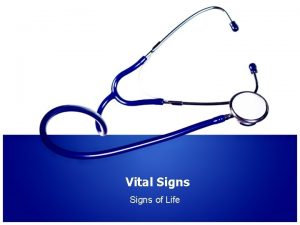Retinal Microvascular Signs In The MESAEye Study Tien
































- Slides: 32

Retinal Microvascular Signs In The MESA-Eye Study Tien Y. Wong, FM Amirul Islam, Ronald Klein, Barbara EK Klein, Mary Frances Cotch, Cecilia Castro, A Richey Sharrett & Eyal Shahar

Historical Perspective Retinal microvascular signs were described in in patients with severe hypertension • Marcus Gunn described these signs in a series of patients with kidney disease in 1898 • • Hypertensive retinopathy classification paper by Keith, Wagener and Barker in 1941 • Keith NM, Wagener HP, Barker NW. Am J Med Sci 1939; Gunn RM. Trans Ophthalmol Soc U K 1892; 12: 124 -5. 197: 332 -43.

Epidemiology 3 -14% general (non-DM) population

Prevalence of Retinopathy By Hypertension Status

Retinal Signs & Incident Stroke The ARIC study Wong TY, Klein R, Couper DJ, et al. Lancet 2001: 358: 1134 -40

Retinal Signs & Incident CHF The ARIC study Wong TY, Rosamond WR, Chang P, et al. JAMA 2005; 293: 63 -69

Retinal AVR & Incident DM AVR reflects relative caliber of retinal arterioles/venules ARIC Study Beaver Dam Study 3 -yr DM incidence 10 -yr DM incidence (Wong et al JAMA 2002) (Wong et al Arch Intern Med 2005)

Retinal AVR & Hypertension and Incident DM

Objectives • Describe prevalence and distribution of retinal microvascular signs in the MESA-Eye Study • Examine associations of retinal microvascular signs with both conventional and novel cardiovascular risk factors, including biomarkers of inflammation, hemostasis & endothelial dysfunction • Examine possible ethnic/racial variations

Assessment of Retinal Microvascular Signs • Non-mydriatic digital retinal photographs of both eyes • Two photographs per eye (optic disc and macula) • Evaluated at University of Wisconsin, Madison • Focal retinal signs (Two eyes) • Focal arteriolar narrowing • Arterio-venous (AV) nicking • Retinopathy (microaneurysm, hemorrhages, cotton wool spots) • Retinal vascular caliber (One eye) • Retinal arteriolar caliber (CRAE) • Retinal venular caliber (CRVE)

AV nicking

Focal narrowing

Microaneurysm Focal narrow AV nicking

Cotton wool spots AV nicking

Measurement of Retinal Vascular Caliber

AV ratio = Relative Caliber of Retinal Artery vs Veins

Study Population 6, 814 MESA Baseline Exam 6, 239 MESA 2 nd Exam 6, 147 Retinal photographs 6, 106 AV nicking 6, 070 Focal narrowing 5, 282 Retinopathy (no DM) 5, 979 Retinal vascular caliber

Prevalence of Focal Retinal Signs

Systolic BP & Focal Retinal Signs

Multivariate Models for Focal Retinal Signs

Retinal Vascular Caliber Arteriolar Caliber Venular Caliber

Retinal Vascular Caliber Arteriolar Venular SBP DBP

Retinal Vascular Caliber Arteriolar Venular Fasting glucose BMI

Markers of Inflammation Arteriolar Venular IL-6 Plasma Fibrinogen CRP

Multivariate Models for Retinal Vascular Caliber

No Associations • Past medical history of inflammatory disease • Asthma, arthritis, and hepatitis, • Medication use • Lipid lowering agents, diuretics, oral contraceptives, HRT, oral steroids, aspirin and NSAIDs, • Hematology/Biochemistry • TNF- • Soluble E-selectin, v. WF, factor VIII • Plasmin-antiplasmin complex, D-dimer, total homocysteine, soluble tissue factor, thrombin activatable fibrinolysis inhibitor, tissue factor pathway inhibitor, soluble thrombomodulin, anti-human heat shock protein 60, remnant -like particle cholesterol • Interleukin-2 soluble receptor chain, Matrix metalloproteinase 3, matrix metalloproteinase 9, • Ig. G to Chlamydia pneumoniae, Herpes simplex virus, Cytomegalovirus, Helicobacter pylori and Hepatitis A

Ethnic/Racial Variations Focal Retinal Signs Model 1: age, gender and center Model 2: Model 1 variables plus for AV nicking: SBP, hypertension, DM, asthma, smoking, glucose, BMI, waist hip ratio, HDL, triglycerides, plasmin-antiplasmin complex, hs. CRP, interleukin-6 and education; for focal narrowing: SBP, hypertension, DM, gum disease, WHR, TG, and education and for retinopathy: SBP and hypertension, smoking, glucose, BMI and education.

Ethnic/Racial Variations Retinal Vascular Caliber Mean difference (95% confidence interval) of arteriolar and venular diameter, comparing Blacks, Hispanics or Chinese with Whites, adjusted for age, gender and center † For arteriolar caliber, additional adjustment for systolic blood pressure, hypertension, diabetes, smoking, alcohol consumption, BMI, plasma fibrinogen, total homocysteine and education; for venular caliber, additional adjustment for systolic blood pressure, diabetes, smoking, BMI, waist hip ratio, glucose, triglycerides, LDL and HDL cholesterol, hs. CRP, plasma fibrinogen, interleukin-6 and education.

Possible Explanations • Racial/ethnic differences in the distribution of CVD risk factors • Blacks and Hispanics were more likely to have DM, obesity, dyslipidemia and systemic inflammation These factors are associated with larger venular caliber But they did not explain the observed racial differences in adjusted models • Racial/ethnic differences in the susceptibility and manifestations of retinal microvasculature to common CVD risk factors? • Differences in refractive errors? • Myopic refraction associated with smaller retinal vascular caliber • Whites and Chinese have a higher prevalence of myopia…

Pathophysiology Diabetes Retinopathy Retinal Venular Caliber Retinal Microvascular Signs Retinal Arteriolar Caliber Hypertension AV nicking Metabolic syndrome Inflammation Endothelial dysfunction?

Conclusion • Different associations of retinal microvascular signs with standard and novel CVD risk factors • AV nicking, focal narrowing, retinopathy associated with hypertension • AV nicking associated with inflammation • Retinal arteriolar caliber is associated with hypertension • Retinal venular caliber is associated with diabetes, dyslipidemia, obesity and diabetes • Findings may provide insights into the different systemic processes associated with retinal microvascular signs and why they predict CVD events

Future Analyses • Associations with subclinical CVD – – CAC and carotid IMT LV mass and function Major and minor ECG abnormalities Endothelial function (? ) • Associations with other measures in MESA – – Lipoprotein subclass/particle size/oxidized LDL Renal function Cognitive function, depression Air pollution • Other Eye endpoints – – – Age-related macular degeneration Diabetic Retinopathy Vein occlusions, epiretinal membranes and other retinal diseases Refraction Visual impairment • Associations with incident CVD events…
 Divided highway begins sign
Divided highway begins sign Retinal disparity psychology
Retinal disparity psychology Papilliedema
Papilliedema Ppv
Ppv Phi phenomenon psychology definition
Phi phenomenon psychology definition Binocular disparity
Binocular disparity Types of perception
Types of perception Algıda gruplama
Algıda gruplama Sakadik
Sakadik Tabletop retinal detachment
Tabletop retinal detachment Retinal ganglion
Retinal ganglion Peripheral vascular disease slideshare
Peripheral vascular disease slideshare Conclusion of screenless display
Conclusion of screenless display Retinal disparity definition psychology
Retinal disparity definition psychology Cystic retinal tuft
Cystic retinal tuft Topcon retinal camera
Topcon retinal camera Appetite nursing diagnosis
Appetite nursing diagnosis Retinal vessels
Retinal vessels Retinal detachment presentation
Retinal detachment presentation Nursing management of encephalitis
Nursing management of encephalitis Autism nursing diagnosis
Autism nursing diagnosis Retinal migraine
Retinal migraine Cochlear nerve
Cochlear nerve Retinopexy
Retinopexy Monocular depth cues of interposition
Monocular depth cues of interposition Difference between natural and conventional signs
Difference between natural and conventional signs The diamond shape is used exclusively for _____ signs
The diamond shape is used exclusively for _____ signs The octagon shape is used exclusively for
The octagon shape is used exclusively for Tien haikoes vir die vredefortkoepel vrae en antwoorde
Tien haikoes vir die vredefortkoepel vrae en antwoorde Kỳ thu tiền bình quân
Kỳ thu tiền bình quân Huy hiệu đội thiếu niên tiền phong hồ chí minh
Huy hiệu đội thiếu niên tiền phong hồ chí minh Quy trình thu chi tiền mặt
Quy trình thu chi tiền mặt Tien tijdvakken kenmerkende aspecten
Tien tijdvakken kenmerkende aspecten

